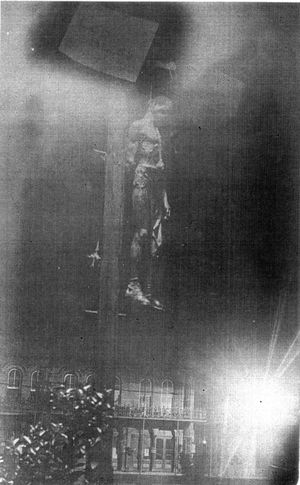Difference between revisions of "Leander Shaw"
(+ image. will add more copy later) |
|||
| Line 1: | Line 1: | ||
| − | [[Image:Leandershaw.jpg|thumb|right|Leander Shaw's body after being lynched]]'''Leander Shaw''' (d. [[July 28]], [[1908]]) was a black man accused of the robbery, rape and murder of a white woman, [[Lillie | + | [[Image:Leandershaw.jpg|thumb|right|Leander Shaw's body after being lynched]]'''Leander Shaw''' (d. [[July 28]], [[1908]]) was a black man accused of the robbery, rape and murder of a white woman, [[Lillie Brewton Davis]]. |
| − | After the crime, Shaw was allegedly found rinsing his bloody shirt in [[Pensacola Bay]], arrested and taken to the hospital where Davis, whose throat had been cut, identified him before dying. Headlines from the ''[[Pensacola Journal]]'' announced the "Brutal Assault by Burly Negro Upon White Lady." | + | After the crime, Shaw was allegedly found rinsing his bloody shirt in [[Pensacola Bay]], arrested and taken to the hospital where Davis, whose throat had been cut, positively identified him before dying. Headlines from the ''[[Pensacola Journal]]'' announced the "Brutal Assault by Burly Negro Upon White Lady." |
| − | A mob was formed shortly thereafter and | + | A mob was formed shortly thereafter and demanded entry to the [[Pensacola Jail]], where Shaw was being held. The Sheriff, [[James C. Van Pelt]], at first attempted to reason with the crowd, and when that failed, Sheriff Van Pelt reportedly deputized the entire crowd, apparently thinking that the mob would have to obey the law and disperse if its members were sheriff's deputies. The tactic failed; instead the members of the crowd stipulated that as deputies they should be given guns and access to the jail. Eventually, members of the crowd stormed the jail. Shaw was dragged from his cell, through the street, to [[Plaza Ferdinand VII]]. He was hanged without a trial from a utility pole in the plaza, and his body was riddled with bullets from the angry crowd. The ''Pensacola Journal'' reported that about 1,000 people witnessed the lynching. |
The crime and hanging are explored in the 2007 documentary ''[[Lillie & Leander: A Legacy of Violence]]'' by Davis's great-great-niece, filmmaker [[Alice Brewton Hurwitz]]. | The crime and hanging are explored in the 2007 documentary ''[[Lillie & Leander: A Legacy of Violence]]'' by Davis's great-great-niece, filmmaker [[Alice Brewton Hurwitz]]. | ||
Revision as of 19:33, 16 May 2007
Leander Shaw (d. July 28, 1908) was a black man accused of the robbery, rape and murder of a white woman, Lillie Brewton Davis.
After the crime, Shaw was allegedly found rinsing his bloody shirt in Pensacola Bay, arrested and taken to the hospital where Davis, whose throat had been cut, positively identified him before dying. Headlines from the Pensacola Journal announced the "Brutal Assault by Burly Negro Upon White Lady."
A mob was formed shortly thereafter and demanded entry to the Pensacola Jail, where Shaw was being held. The Sheriff, James C. Van Pelt, at first attempted to reason with the crowd, and when that failed, Sheriff Van Pelt reportedly deputized the entire crowd, apparently thinking that the mob would have to obey the law and disperse if its members were sheriff's deputies. The tactic failed; instead the members of the crowd stipulated that as deputies they should be given guns and access to the jail. Eventually, members of the crowd stormed the jail. Shaw was dragged from his cell, through the street, to Plaza Ferdinand VII. He was hanged without a trial from a utility pole in the plaza, and his body was riddled with bullets from the angry crowd. The Pensacola Journal reported that about 1,000 people witnessed the lynching.
The crime and hanging are explored in the 2007 documentary Lillie & Leander: A Legacy of Violence by Davis's great-great-niece, filmmaker Alice Brewton Hurwitz.
References
- Scott Satterwhite and Duwayne Escobedo. "Lillie & Leander: A Legacy of Violence" - Independent News, April 19, 2007.
- Sandy Hollow Productions - documentary production company website
